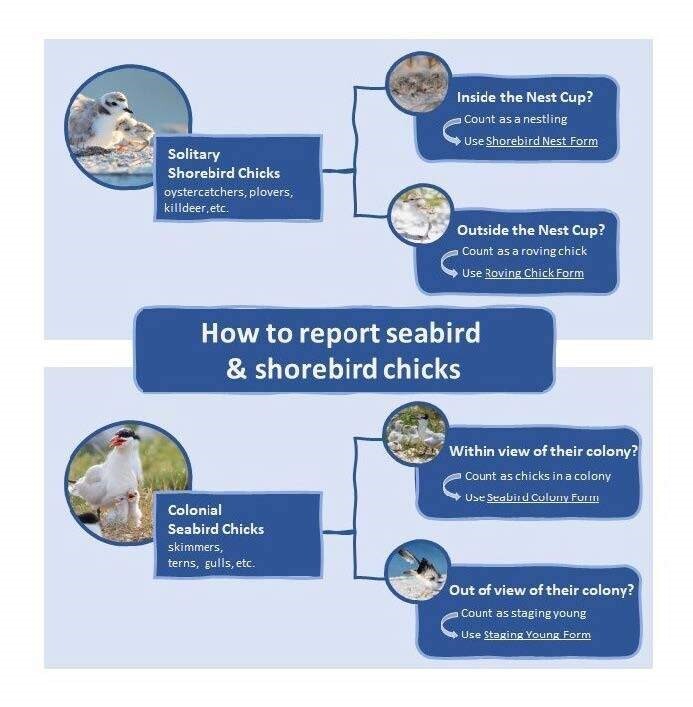|
August 5-11: The final count window for the Breeding Bird Protocol. If you're surveying a
route with active nesting, weekly surveys help capture information about peak counts.
How can we help protect beach-nesting birds?
All shorebirds and seabirds nesting in Florida are federally protected by the Migratory Bird Treaty Act. During breeding season for beach-nesting birds, people visiting Florida’s coastlines can help ensure nesting success by going around – rather than through – flocks of birds on the beach. Beach-nesting birds benefit from at least 300 feet of space to avoid causing them to fly off, leaving hard-to-see chicks and eggs vulnerable to being stepped on and potential harm from being exposed to the elements and predators. Even when not nesting, shorebirds and seabirds use the beach as important habitat for resting and foraging. Learn more ways to share the shore and help beach-nesting birds at MyFWC.com/Shorebirds.
 |
|
Monitoring successes in Volusia County
This June saw two exciting monitoring success stories from Halifax River Audubon in the Volusia County FSA Shorebird Partnership! On the first day of the June count window, a downy least tern chick was found wandering the parking lot of a Dollar General in Ormond by the Sea and transported to the Marine Science Center. Staff at the Marine Science Center knew they needed to reunite the chick with its parents as soon as possible.
|
They contacted the Ormond Beach Fire Department and met a big truck at the apartment complex, with assistance from the building manager. The crew from Station 93 used their tall ladder to return the chick to the rooftop and its parents.
Two weeks later, another wayward chick was returned to a rooftop. The chick was found in a balcony planter by a resident and was again transported to the Marine Science Center. The Volusia County Fire Department rose to the occasion: the Station 11 crew positioned their ladder and placed the chick on the rooftop. But it promptly ran off the other side of the roof and down onto another balcony! Fortunately, the crew located the bird and returned it to the rooftop once again.
The Florida Shorebird Alliance thanks everyone involved for finding these chicks and returning them to their parents!
Photo by Pauline Dulang

Late Season Chick Data
The season may almost be over, but there are still shorebird chicks and seabird young running (and flying) around Florida’s beaches! Late-season surveys capture important data about this season’s juveniles, especially fledglings. Documenting where juvenile shorebirds and seabirds are hanging out as well as their age, the number of adults with them, and (for shorebirds) their natal nest (if known) helps inform adaptive management and can be used to refine abundance and productivity estimates.
How you report late-season chick data in the Florida Shorebird Database (FSD) varies by species and chick age. Seabird chicks of any age that are still within or very near their colony should still be counted as part of their colony using the Seabird Colony Form. Seabird flight-capable chicks that have ventured away from their colony should be documented as staging young on the Roving Chick/Staging Young Form. Avoid double counting seabird chicks and adults. Seabird chicks only need to be reported on one form at a time. For example, if you use the Seabird Colony Form to document flight-capable chicks observed inside their colony, then you do not need to also document them using the Roving Chick/Staging Young From.
Unlike seabirds, shorebird chicks typically leave their nest cup shortly after hatching. Downy, feathered, and flight-capable chicks seen outside of their nest cup should be documented as roving chicks using the Roving Chick/Staging Young Form. Rarely will you observer downy chicks still in the nest cup, but if you do, these chicks are considered nestlings and can be documented on the Shorebird Nest Form.
Shorebird chicks can be tricky to observe as they tend to be more secretive than seabirds. Sometimes you may observe a shorebird breeding pair acting like they have chicks, but no chicks were seen. Did you know that you can still report these observations? If you are confident that the breeding pair has a brood based on the pair’s behavior (this may differ by species), you can enter this data on the Roving Chick/Staging Young Form. And don’t forget the natal nest! You can tie shorebird roving chicks back to the nest they hatched from, if known!
Check out the FSA’s Aging Guides for help identifying the age of shorebird and seabird juveniles. To get an idea of when you should expect to see chicks during your survey, checkout the Timing of Ground Nesting and Flightless Chicks guide. As always, we are happy to help answer any questions about chick observations or other quandaries. Email us at FLShorebirdDatabase@MyFWC.com!
Thank you to all FSA partners for your hard work this breeding season! Keep up the fantastic work!

Interested in IBNB Monitoring?
Are you interested in getting experience surveying Imperiled Beach-nesting Birds (IBNBs)? Annual shorebird and seabird monitoring in Florida is conducted through the Florida Shorebird Alliance network of partnerships. If you are interested in becoming an IBNB Permitted Monitor and would like to gain survey experience with skilled bird monitors in the network, please email shorebird@MyFWC.com. August is the last month to gain survey experience if you want to become an IBNB Permitted Monitor in 2024.
And remember, the IBNB Permitted Monitor application is now available. For detailed application instructions, please read “How to become an IBNB Permitted Monitor” found on the FWC’s IBNB Permitted Monitor webpage.
|